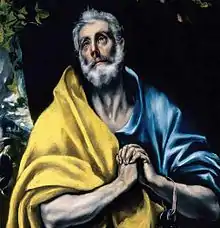Saint Peter and Judaism
The relationship between Saint Peter and Judaism is thought to have been fairly positive.
| Part of a series on |
| Saint Peter |
|---|
 |
| In the New Testament |
| Other |
Apostle to the Jews
Paul the Apostle says that Peter had the special charge of being apostle to the Jews, just as he was apostle to the Gentiles. Another apostle, James, is regarded as the leader of the Jewish Christians.[1]
Incident at Antioch
The incident at Antioch refers to a meeting between Paul the Apostle and Peter described in the Epistle to the Galatians.[2] As gentiles began to convert from Paganism to Christianity, a dispute arose among Christian leaders as to whether or not gentiles needed to observe all the tenets of Mosaic Law. In particular, it was debated as to whether gentile converts needed to be circumcised or observe the dietary laws. Paul was a strong advocate of the position that gentiles need not be circumcised or observe dietary laws. Others, sometimes termed Judaizers, felt that gentile Christians needed to fully comply with the Mosaic Law.
Council of Jerusalem
Peter was a leader at the Council of Jerusalem. He ultimately stood a middle-ground between the Jewish Christians and the Gentile Christians. It was agreed that avoidance of idolatry, fornication, and the eating of flesh cut from a living animal, should be demanded of gentiles who wished to become Christians.[3]
Tosaphists
The Tosaphist Rabbeinu Tam wrote that Peter was "a devout and learned Jew who dedicated his life to guiding gentiles along the proper path". Tam also passed on the traditions that Peter was the author of the Sabbath and feast-day [4] prayer Nishmat, and this was a popularly held belief through the Middle Ages.[5] Otzar Hatefillah, quoting Mahzor Vitri, pointedly denies this claim, offering instead Simeon ben Shetach as the probable author. Peter is also thought to have authored a prayer for Yom Kippur in order to prove his commitment to Judaism despite his work among Gentiles.[6]
Other
According to an ancient Jewish tradition, Peter was sent by the rabbis in order to move Christianity in its own direction, to prevent it from being considered another branch of Judaism.[7]
References
- "About the Apostles Peter and Paul". Orthodoxphotos.com. Retrieved 17 December 2014.
- Dunn, James D.G. The Incident at Antioch (Gal 2:11-18) Journal for the Study of the New Testament 18, 1983, pg 95-122]
- Badenas, Robert. Christ the End of the Law, Romans 10.4 in Pauline Perspective, 1985 ISBN 0-905774-93-0
- "Nishmat". Headcoverings-by-devorah.com. Retrieved 17 December 2014.
- Bekkum, Wout (2005). "The Poetical Qualities of The Apostle Peter in Jewish Folktale". Zutot: Perspectives on Jewish Culture. 3: 16–25. doi:10.1007/1-4020-2628-5_3. ISBN 1-4020-2627-7. Cite journal requires
|journal=(help) - H.J. Zimmels (July 1957). "Rabbi Peter the Tosaphist". The Jewish Quarterly Review. 48 (1): 51–52. doi:10.2307/1452745. JSTOR 1452745.
- Julius Eisenstein (1915). Otzar HaMidrashim. Mishor. p. 557. https://www.sefaria.org/Otzar_Midrashim%2C_Aggada_of_Shimon_Kippa%2C_Introduction?lang=bi